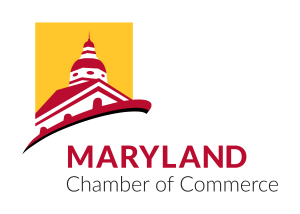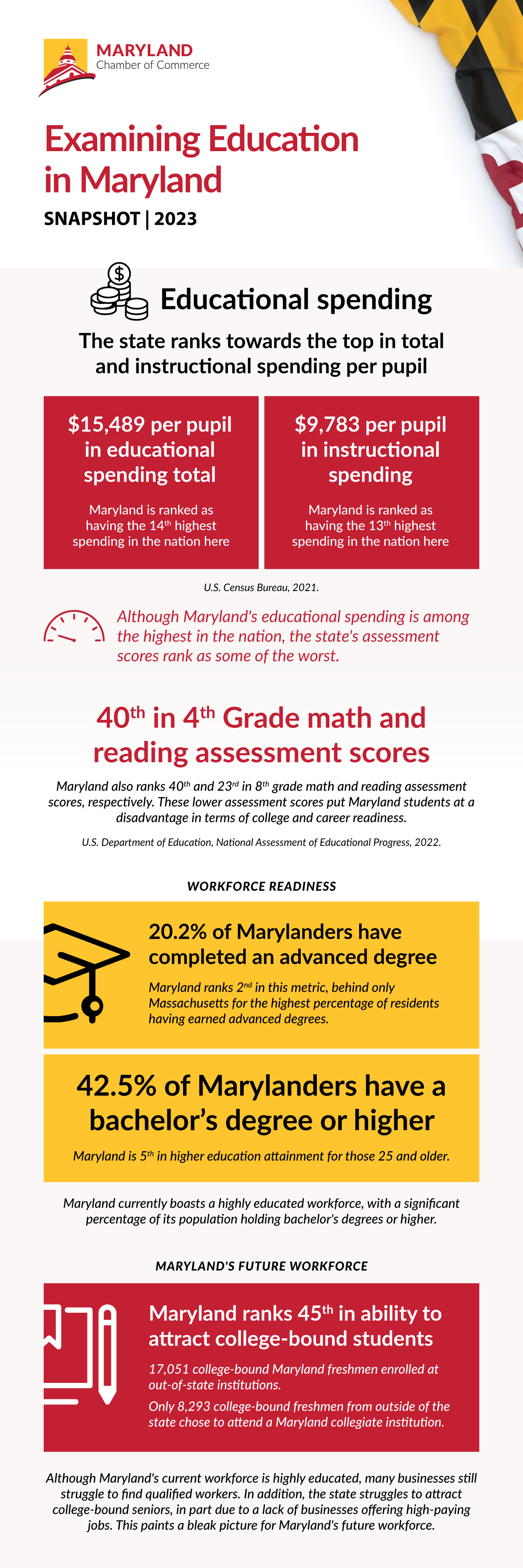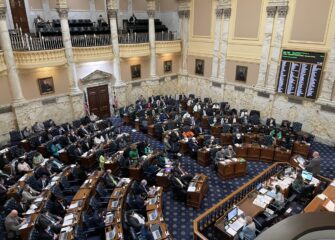
Examining education in Maryland.
Maryland’s education system plays a critical role in shaping the state’s economic competitiveness, workforce and policy priorities. Understanding where Maryland stands when it comes to indicators around education can be helpful to businesses, policymakers and educators alike, helping to identify where improvements are needed to make Maryland more competitive.
As you will see in the data, Maryland ranks as having some of the highest per pupil spending in the nation, yet ranks as having some of the worst performance when it comes to assessment scores. Additionally, while the state currently boasts a highly educated workforce, Maryland ranks 45th for attracting college-bound students, which signals trouble for Maryland businesses who already face difficulties in finding qualified, skilled workers to fill available jobs.
We must work together to change this narrative to ensure Maryland’s educational system is efficient, competitive and adept at creating a highly skilled workforce. Otherwise, we will continue to lose highly educated workers to other states, and our businesses will struggle to find qualified, skilled workers for available jobs, all leading to challenges for our state’s economy.
Explore Data on Maryland’s Educational Landscape
Economic Indicator Spotlight: Examining Education in Maryland

Here’s what the data indicates:
Maryland ranks as having some of the highest per pupil spending in the nation.
- Maryland demonstrates a strong commitment to education through significant investments in the public school system. The state ranks among the top in total spending per pupil, instructional spending per pupil and support services spending per pupil. However, assessment scores do not align with the anticipated outcomes. The contradiction between spending and assessment scores suggests a need to reassess resource allocation to improve student achievement.
Despite the high spending, Maryland ranks poorly when it comes to educational assessment scores.
- Evaluating Maryland’s educational assessments provides insights into education quality and student preparedness for higher education and the workforce. The state’s assessment scores for 4th and 8th grade students in reading and math are relatively low compared to other states. These scores put Maryland students at a disadvantage in terms of college readiness and future career opportunities –highlighting challenges within the education system.
Maryland currently boasts a highly educated workforce.
- Maryland boasts a highly skilled workforce, with a significant percentage of its population holding bachelor’s degrees or higher. This educational achievement makes the state an attractive destination for businesses and industries that rely on a knowledgeable and skilled labor pool.
However, the state struggles to attract college-bound students.
- Attracting and retaining college-bound high school graduates is vital for Maryland’s long-term economic growth. However, the state struggles to compete with other states in this aspect, indicating a need to address factors that make other states more appealing, such as better job opportunities and a competitive higher education system. Retaining talented students within Maryland contributes to the future workforce.
Why it matters:
While the state currently boasts a highly educated and skilled workforce, businesses in Maryland have difficulties finding qualified, skilled workers to fill available jobs. Unfortunately, data regarding Maryland’s educational spending, assessment and ability to attract college-bound students paints an even more challenging environment ahead. Despite significant investments in education, Maryland’s educational assessment scores are ranked as some of the worst in the nation, and the state’s educational and business landscape is not competitive enough to be attractive to college-bound students.
These indicators highlight the need for collaborative efforts between policymakers and educational leaders to identify strategies that improve the efficiency and quality of Maryland’s education system. By doing so, Maryland can enhance opportunities for its students and foster a skilled, highly competitive workforce that will attract businesses and drive economic growth.
Data Sources:
- American Community Survey, 2021
- U.S. Department of Education, Fall 2020
- U.S. Department of Education, National Assessment of Educational Progress, 2022
- U.S. Census Bureau, 2021
Additional Reading:
- How Education and Training Affect the Economy, Investopedia, 2022
- What Do Test Scores Really Mean for the Economy? Education Week, 2018
- U.S. Public Education Spending Statistics, Education Data Initiative, 2022
- State and Local Backgrounders: Elementary and Secondary Education Expenditures, Urban Institute
- Increasing Education Spending Does Not Equal Higher Test Scores, American Legislative Exchange Council, 2014
Explore Data on Maryland’s Educational Landscape
Building a prosperous, competitive economy takes understanding of where we stand today.

Explore the 2023 Maryland Competitiveness Redbook and our economic indicator spotlights for more information on where Maryland stands – and what it means for our economy, for our state and for business.
We encourage you to use this data to understand the realities facing Maryland’s economy and business community. By working collaboratively to remove obstacles, update policies, and create a pro-business atmosphere where both businesses and communities thrive, we can make Maryland a top competitor for business with an economy that leaves no one behind.



